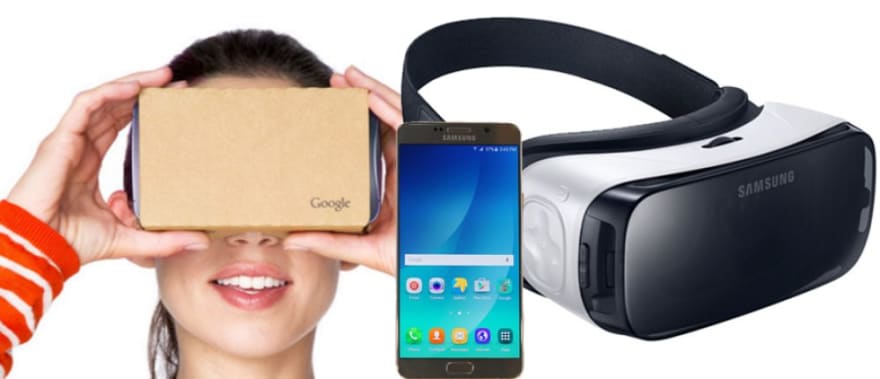With a number of new gadgets rapidly emerging on a tech horizon, VR market is steadily moving to its rise in popularity among all the demographic groups. In the recent years, we have seen the price range for the regular VR devices varying between 800$ for HTC Vive in 2016 and 3$ for Google Cardboard, which is a glaring indicator that VR market is moving towards grasping the biggest audience size possible.
However, likewise, the Spiderman's most notable quote, this power in sheer numbers comes with a high level of responsibility regarding the quality of the products that these new VR mobile gadgets bring upon themselves. Not having to deal with a convoluted set of wires and the overall usage simplicity are very welcomed perks to alleviate a lot of users' concerns, however, a drastic decrease in a hardware department is imminent and severely impacts the graphical fidelity.
After seeing a wave of fresh headsets from Carl Zeiss, LG, Merge, Homido, Freefly, Bnext, Pasonomi and tons of other manufacturers, mobile VR market competition is tight as never before, but we will take a closer look at the most prominent instances who set the pace in this intriguing race.
Gear VR
Judging by its most powerful representative, Gear VR is a prime example of a relatively cheap VR solution(compared to its desktop-based counterparts), whose performance may greatly vary based on which specific phone model is chosen, starting from Samsung Galaxy S6/Note and including all the newer flagship models. Unlike the other mobile VR headsets, modern Samsung devices utilize the latest versions of Exynos and Snapdragon GPUs, powered by ARM-Mali and Adreno GPUs, therefore, can produce some stunning imagery level with up to 2960x1440 resolution. Despite impressive graphical level on the latest models, Samsung cannot be boastful of its controller system, that is why common console-like devices come into place, for example, SteelSeries Stratus XL.
For those who are not to pay extra money for additional gadgets, Gear VR controller will still be useful for shooting, it can also help you do things like hold and grip objects in VR naturally. It greatly helps in tracking your hands' position and location and makes VR area fun and approachable even for its newest members.
The games are greatly willing to cooperate with Gear VR, that is why such hits as Minecraft and Land's End are at players' disposal. Furthermore, lightweight and the overall convenience level, regardless of the user's head size, make this headset feel like a part of the body, which promotes it to be a clear winner among the other contemporary mobile VR solutions.
Google Cardboard
Google Cardboard, on the other hand, is a hallmark of a whole VR industry at its core and is a clear indicator which direction it is moving towards. Demanding only a few bucks for a whole product that can also be composed manually, it can utilize a multitude of smartphones that have a display in a broad range of 4.7-6.1 size and use the Android platform. Gaze-based targeting(and triggering the actions) is its fairly controversial feature as it simultaneously restricts the players from a more convenient navigation and using the buttons, however, some users find it enjoyable to exclusively rely on their intuition and reflexes to operate this headset.
Speaking of controllers, there is no need to buy a relatively expensive console-alike joystick, even a handmade printed marker schematics can serve as a great navigating tool. For that matter, Realteer have developed RealTrigger, a simplistic printed image on a piece of carton that only requires the smartphone's camera not to be obstructed by a Cardboard material and allows for easy pointing inside a VR app. Despite its name, this device can't have a "trigger" button and can only be used in fairly plain apps with modest graphics but still shows a notable level of effectiveness, being practically free for the wide audience usage.
Google Daydream
The Daydream View is another fine solution for a wide audience but is only compatible with the newer phones. Despite lacking in the games and apps department, it can greatly compensate their absence by including such services as YouTube, HBO Now, and Netflix. Being made from fairly lightweight and soft materials, it can also be boastful of its great comfort level. By only utilizing such Android flagships like Google Pixel 2, Pixel 2 XL, both Samsung Galaxy 8 versions, and LG V30, Daydream is capable of creating nice visual quality for the apps and such technology as WorldSense is a large part of it. Not only it greatly improves the players' movements and makes them natural without installing external sensors but can also be a nice physical training tool to practice dodging, ducking, and leaning without having to use a cable that creates an additional immersion level.
Daydream controller, however, is a double-edged sword. To make their product even more compact, Google refused to add a number of buttons that Gear VR did which lead to it becoming more welcoming towards beginners but less immersive for the experienced enthusiasts. An addition of a DayDream controller emulator via Bluetooth was a welcomed feature that enabled smooth navigation by having a second compatible phone, being able to inherit the best features from a VR Box remote controller concept.
Games Quality/Quantity
In the graphics department, virtually every game looks to inherit a minimalistic style of its objects, making every game look like an indie developed product due to severe hardware limitations.
Given a whole list of available apps, it is safe to say that the supply of games is still lacking and the market is open for the visually stunning products to fill the niche. Currently, the pool of games mostly consists of the "endless runner" type of apps that rely on players to pass through locations without staring at the computer-generated environment. Only the games based on exploration process can be boastful of their graphics, such as Minos Starfighter, Galaxy, Hardcore, InMind and Space, however, they're either done in space or within a futuristic luminous environment. Despite having special tools like Seurat that enabled high-fidelity rendering for mobile VR headsets in real time, we are still yet to see an app that would contain dense foliage and detailed game objects.
Battery/Temperature/GPU/CPU
Apart from being inferior in a hardware capability department compared to a desktop platform, mobile VR concept also has to battle its limited power budget and the constraints it applies when managing the temperature. Having to deal with a limited battery life-cycle, mobile gadgets need to take care of an effective voltage level that is usually limited to 4 watts when a desktop VR GPU can consume more than 150 watts. Tight details composition and a high proximity of a mobile device to a headset also lead the developers to decreasing the voltage level to a bare minimum for keeping the battery stable, effective and prevent it from overheating.
Furthermore, mobile gadgets generally possess very distinctive logics in terms of CPU/GPU power distribution which make CPU willing to work as little as possible, leaving all the major processing tasks for the GPU. This often leads to an inability of a graphical chip to execute such vital steps as physics calculations, game logics, and background services, not to mention essential VR tasks as drawing calls for enabling stereoscopic rendering.
This is when common graphical solutions come into place, designed to alleviate the pressure from mobile GPUs. Foveated rendering is a rapidly approaching technique that, combined with an eye-tracking technology, allows for reducing the load on a GPU by solely rendering user's frontal point of view at full resolution and decreasing its quality in a rear vision.
Multiview rendering, on the other hand, is a cross-platform method of processing stereoscopic rendering with a single draw call instead of making a new one for each view point. For now, it is only supported by Qualcomm Adreno and ARM Mali devices, however, this practice can further expand to other mobile hardware manufacturers, given its high effectiveness in reducing the GPU/CPU load by up to 50%.
Resolution
The resolution number is another important factor which further restrains the creation of a decent image quality for mobile devices. Even those who have experienced the beauties of QHD or double 1080×1200 screens could have noticed that its proximity to their eyes negates the visual effect by a ton. Aliasing is a tall order in such circumstances and even a high resolution can't always become a saving grace when making the edges look smooth. Furthermore, 4K is a big stress even for powerful standalone VR gadgets, let alone, their mobile counterparts that should maintain a high refresh rate of 60+ to secure a decent immersion level.
For that matter, compression is a great choice, however, among mobile manufacturers, only ARM Mali is now capable of effectively using this technique that allows for saving up to 50% of bandwidth compared to uncompressed textures.
A classical method of simply reducing the vertex data geometry from 32-bit down to 16-bit accuracy is still in place, however, its implementation will mostly depend on developer's priority in performance/visual appeal ratio.
Tessellation can also come in handy when increasing the visual quality for simpler objects, however, requires some additional GPU power. Forward Pixel Kill and Deferred Rendering can help developers ignore rendering occluded pixels, meanwhile, the Tilling method can enable separating the images into multiple tiles to be rendered separately and further alleviate the bandwidth pressure.
Market Potential
According to Statista, following the vast sales numbers growth across the whole VR market, mobile gadgets have asserted themselves as a dominant force in a local battle against PC-dependant platforms. While leading the charts, in 2016 both Gear VR and Google Cardboard made their competitors look shy, only leaving the space for about ~10% of the whole market, however, HTC Vive, Oculus Rift, and PlayStation VR managed to recover in 2017 thanks to severely cutting the prices for both gadgets and devices which led their market share to increase up to ~40%. Introducing a big chunk of games previously available exclusively in non-VR environment also played its role in greatly improving their audience magnitude.
However, the future of VR mobile platform, despite standalone gadgets bouncing back, still looks very promising. First of all, big companies moving towards standalone headsets like Facebook pushing Oculus Go is a clear indicator that mobile gadgets managed to set the pace for everyone else to make their products affordable and convenient. Furthermore, an ability to inherit players' progression from the ported games will be another key factor on whether or not a big part of users will commit to migrating towards a chosen VR platform.
Judging by the numbers and the capabilities that the Google company possesses, Daydream view is a clear winner when it comes to the gaming and exploration areas potential(gained new 2.15M owners in 2017). The developers found a tight niche of keeping their gadget's price tag fairly low, and despite demanding rather costly compatible phones, it is nowhere near to the requirements that the regular standalone headsets have (additional expenses of a ~1000$ PC). Furthermore, while being able to introduce Leap Motion and a number of other features, Google also plans to steadily broaden the range of smartphones that can operate Daydream view.
From the publishers' standpoint, VR market is a relatively new activity field, let alone VR mobile area, however, many of the AAA publishers have already joined the fray. Such moguls as Ubisoft(Star Trek Crew), Bethesda(Skyrim VR, Fallout 4 VR), Microsoft(Minecraft VR), Crytek(The Climb), and Capcom(Resident Evil 7 VR) have already released their products to the wide audience of HTC Vive, Oculus Rift, and PS VR users. And given how big of an edge mobile VR market has in headset owners figures, we are set to see a big influx of the major game publishers to step into this area. As we have seen the PC/console-oriented companies shifting towards mobile games years ago, the similar move for mobile VR experience is just around the corner.
Despite a number of games have been made by independent publishers to attract the players to a breakthrough confluence of cheap and gorgeous VR leisure, it is the AAA giants that usually define whether or not the industry will be successful. Therefore, when we see the companies like Tencent bringing mobile VR game development into their MMO products, it will not come as a big surprise whatsoever. Apart from that, it is hard to ignore how every day-to-day contraption, including electronics, is getting more and more compact and we are yet to see any reason for mobile VR to become an exception.
Conclusion
Despite a number of difficulties that a transition towards mobile gadgets brings upon, VR segment is steadily moving forward to approach the biggest masses of users who have relatively powerful smartphones and are willing to give an immersive interaction a try. Being in a stage of a rapid growth, some of the prime VR development technologies provide more and more ways to expand the batteries' lifetime, maintaining the high frame rate, and improving in a visual quality department.
The controls, in general, didn’t see a major overhaul. Only the most affordable headsets move away from the conventional button-pushing mechanics, starting to rely on the gazing technique to impact the in-game objects. In the end, it can greatly reduce the price tag if there are neither buttons provided nor outside controller to manipulate with.
From the gameplay standpoint, we haven't seen too sizeable leaps for the vast majority of games in terms of their depth, likewise, the regular mobile games failed to deliver many unique mechanics due to severe restrictions in hardware capabilities and the keyboard/mouse kit still being superior to other types of controllers. However, given the price/value ratio that such games are ready to bring upon, this is a nice and welcoming area for the new players who seek for relaxation in short gaming sessions. And with the increase of mobile hardware potential, we a set to see lots of improvements in the upcoming years granted that the unparalleled convenience will always be the driving force for further development in this area.







Top comments (0)